Why Your Home Renovation Needs a Designer (And What to Expect When You Hire One)
There’s a moment in every renovation when the Pinterest boards stop helping. When the paint chips multiply on your counter like accusations. When you realize that “open concept” isn’t a style choice—it’s a thousand interconnected decisions you didn’t see coming, each one structural, financial, irreversible. And the gravity of that reality suddenly feels paralyzing.
This is the moment most homeowners wish they’d called a designer six months earlier.
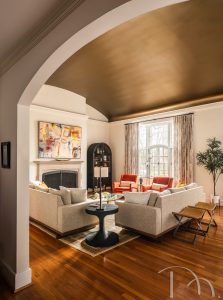 What had been painted a boring white, the barrel ceiling in a warm copper tone is the crowning jewel of this inviting living room./Photo by Karen Palmer
What had been painted a boring white, the barrel ceiling in a warm copper tone is the crowning jewel of this inviting living room./Photo by Karen Palmer
The True Cost of Going It Alone
We live in a DIY culture that insists you can learn anything from a YouTube tutorial, that professional guidance is indulgence rather than investment. But here’s what that seductive narrative conveniently omits: Your home renovation isn’t a practice round.
A load-bearing wall doesn’t have a delete button. There’s no undo for tile that’s already been grouted. No algorithm can tell you how a space actually feels when you’re living in it every single day—when you’re making coffee in that kitchen at 6 AM, when you’re hosting the dinner party that matters, when you’re moving through those rooms in the quiet moments that make up a life.
The homeowners who come to us mid-renovation—after costly mistakes, contractor disagreements, and months of decision fatigue—all say the same thing: “I thought I could figure it out myself.”
The truth? Maybe you could. Eventually. But at what cost?
Not just financially—though the budget overruns from trial and error are painfully real. But emotionally, too. The endless second-guessing. The strained relationships when opinions clash. The quiet fear that you’re creating something you’ll have to live with—and regret—for years.
This is what we mean when we say design isn’t just about what you see, it’s about how it feels. And getting that right takes more than inspiration. It takes expertise.
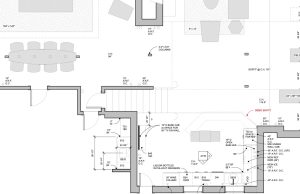
Thousands of details go into the planning of what may seem like a simple remodel. That is one of the stumbling blocks of a DIY project, and one of the superpowers of a good designer./Floor plan by Marcia Moore Design.
What Professional Design Actually Prevents
We began working with a couple who were well into the process, having hired their contractor, chosen some of the finishes, and developed what they believed was a clear vision for their whole-home renovation. They reached out to us when the process became overwhelming, and they were at a stalemate on decisions.
In our first consultation, we identified three decisions that would have created significant, costly problems:
The layout they’d planned would have blocked the home’s natural light flow and created circulation patterns that seemed perfectly functional on paper but would have felt awkward, even claustrophobic, in daily life..
The materials they’d selected for their kitchen were individually beautiful—we understood exactly why they’d chosen them—but required maintenance routines completely incompatible with their actual lives. Two small children, two large dogs, a genuine love of entertaining. These weren’t just aesthetic choices; they were setting themselves up for years of frustration.
The timeline was aggressive to the point of fantasy, setting up an inevitable choice between compromised quality or substantial delays and the contractor conflicts that follow.
We redesigned the layout to honor their vision while enhancing flow and preserving the light that makes a home breathe. We sourced alternative materials that met every aesthetic criterion while delivering the durability their lifestyle demanded. We established a realistic timeline so their contractor could actually deliver—and feel confident delivering.
The result? A renovation that came in on budget, on schedule, and created a home they described as “exactly what we wanted, but better than we imagined.”
This is what professional expertise provides. Not telling you what to want but translating what you do want into reality while preventing the costly mistakes that inexperience inevitably brings. We’re not here to impose our vision. We’re here to make yours possible.
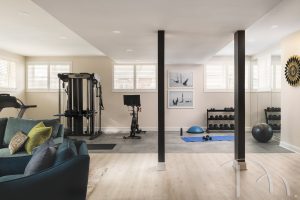
A different vinyl floor was used to delineate the workout space from the gathering space in this lower-level remodel./Photo by Karen Palmer
___________________________
The Collaborative Process: What It Actually Looks Like
Hiring a designer doesn’t mean surrendering control of your vision. It means gaining a partner with decades of experience who can bring that vision to life—someone who’s navigated these decisions hundreds of times and knows where the hidden pitfalls lie.
Here’s what that partnership truly looks like:
Discovery: Understanding Your Story
We begin by listening. Not just to how you want your space to look, but to how you want to feel living in it every day. What frustrates you about your current home? What moments of joy do you want more of? How do you actually move through your days?
This isn’t a questionnaire. It’s a conversation. Because good design doesn’t come from a template—it comes from understanding the human story we’re honoring.
Your Pinterest boards, your magazine clippings, your half-formed ideas—we help you understand the why behind what attracts you. Is it the color palette? The quality of light? The sense of calm? The sophisticated simplicity? Once we understand what you’re truly responding to, we can translate that inspiration into a cohesive vision that works with your architecture, your budget, your lifestyle, and your long-term goals.
Strategic Planning: The Decisions That Matter
We guide you through the hierarchy of decisions—what needs to be decided now, what can wait, and what will impact everything else downstream.
We show you the ripple effects of each choice. How your flooring selection influences your furniture scale. How your lighting plan affects your color palette. How your storage solutions shape your daily routines. How the height of your kitchen island changes the way your family gathers.
Every element feels intentional—beautiful not just because it looks good, but because it serves a purpose in the life you’re actually living.
Execution Partnership: Bringing It to Life
We coordinate with your contractor, managing timelines, troubleshooting the inevitable challenges, and making the thousands of small decisions that keep a project moving forward rather than stalling in indecision.
You’re present for everything that matters but freed from the exhausting minutiae. You can look forward to your renovation with excitement rather than dread. You can trust the process rather than losing sleep over it.
The Reveal: Design That Breathes
The final result isn’t just visually pleasing. It’s a home that feels so natural, so right, you forget to notice the design itself. You experience only comfort, flow, and the profound sense of being exactly where you belong.
Good design shouldn’t announce itself. It should simply make you feel at home.
The room breathes. And so do you.
___________________________
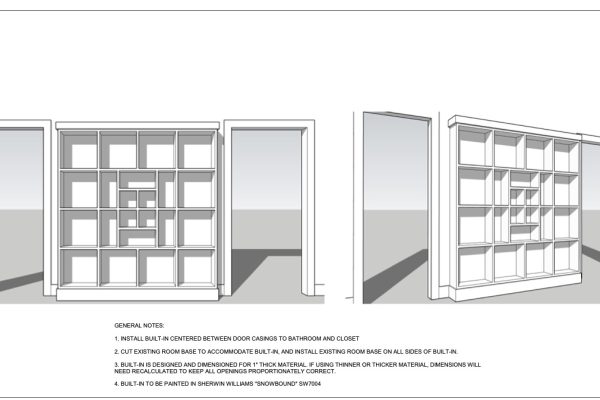
we created this bookcase design for a client who wanted to house books and treasured finds. Small spaces for tiny treasures sit in the middle of the design./Floor plan by Marcia Moore Design.
___________________________
What to Expect: The Honest Truth About Investment
Let’s address the question everyone asks but hesitates to voice: What does professional design actually cost, and is it worth it?
The Investment:
Professional design services typically represent 10-20% of your overall renovation budget. For a $200,000 renovation, expect $20,000-$40,000 in design fees.
We know that’s not insignificant. But here’s the context that matters:
The Return:
Error Prevention: We help you avoid expensive mistakes—change orders, do-overs, structural corrections—that often cost clients two to three times our fees. One avoided mistake can pay for the entire design investment.
Value Optimization: We know where to invest for maximum impact and where to save without compromise. We have relationships with vendors, knowledge of materials, and understanding of what actually matters versus what’s just marketing.
Time Savings: What might take you months of research, second-guessing, and decision fatigue, we help you accomplish in weeks. Your time has value. Your peace of mind has value.
Stress Reduction: This can’t be quantified on a spreadsheet but ask any client—it’s worth the investment on its own. The difference between dreading your renovation and trusting it is immeasurable.
Resale Value: Thoughtful, professional design pays dividends when you sell. Buyers recognize quality. They feel it the moment they walk in.
But here’s what the numbers don’t capture: the difference between a house you live in and a home that lives with you. Between a space that looks good in photos and one that feels good every single day. Between a renovation you survived and one you’re genuinely proud of.
That’s the real return on investment.
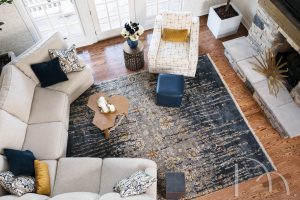
This cozy hearth room was designed for fire and TV viewing by angling the sectional, so every seat faces the fire and TV above it. It is also the perfect spot for an intimate conversation or reading a book./Photo by Karen Palmer
___________________________
The Questions We Hear Most
“Can I just hire a designer for a few hours of consultation?”
You can. But it’s like hiring a doctor for diagnosis without treatment. We can identify what’s wrong, point out the potential problems, offer some initial direction. But we can’t prevent the challenges that emerge during execution, make the tactical decisions that ensure success, or guarantee your vision comes to life as you imagined it.
Design isn’t just about the big ideas. It’s about the thousand small decisions that make those ideas work in reality. That’s where expertise matters most.
“What if I don’t like what the designer suggests?”
This isn’t about imposing our taste on your home. It’s about understanding your taste more deeply than you might yourself—seeing the patterns in what you’re drawn to, understanding what you’re actually responding to, and translating that into spaces that feel authentically yours.
If something feels off, it means we haven’t fully captured your vision yet. And we keep working—refining, adjusting, exploring—until we do. Your home should feel like you, not like us.
“How involved will I be in the process?”
As involved as you want to be. Some clients want to review every decision, be present for every selection, understand every trade-off. Others prefer to trust our expertise and focus on the big-picture moments.
We adapt to your preferred level of engagement. This is a partnership, and partnerships work differently for different people.
“What if we go over budget?”
We establish realistic budgets upfront and track every expense throughout the process. If unexpected costs arise—and in renovation, they sometimes do—we present your options and trade-offs clearly. We show you where you can adjust, what the implications are, and what we recommend.
No surprises. No budget creep that you don’t see coming. Just honest, transparent partnership.
___________________________
When to Bring in a Designer
The best time to hire a designer? Before you do anything else! Before you start making any decisions. Before you start your floor plan. Before you hire your architect or contractor. Before you select finishes. And definitely before you begin demolition.
The second-best time? Right now, wherever you are in the process.
We’ve taken on projects at every stage—blank-slate new construction, early planning phases, mid-renovation rescues when things have gone sideways. Earlier is easier, certainly. But it’s rarely too late for professional guidance to make a meaningful difference.
Even if you’re already underway, we can help you course-correct, avoid future mistakes, and ensure the rest of your project unfolds with intention rather than anxiety.

This custom dresser encompasses the entire wall, with storage sized for every need. It also encapsulates the TV to minimize a usual eyesore./Photo by Karen Palmer
___________________________
The Decision You’re Actually Making
Here’s what hiring a designer really means:
You’re choosing confidence over second-guessing. Professional validation that your investment makes sense, your decisions are sound, your vision is achievable. You’re choosing to trust the process rather than lose sleep over it.
You’re choosing partnership over isolation. A collaborator with years of experience who wants to honor your story, understand your life, and help you create spaces that feel like home—not just look like a magazine.
You’re choosing intention over accident. Design where every choice has purpose, every element enhances your life, every detail contributes to the whole rather than competing for attention.
You’re choosing to invest in what you experience every day—your home, your sanctuary, your backdrop for the life you’re building—for years to come.
This is what we mean when we say design is about how it feels.
Your home should be a living philosophy—not a static showcase, but a space that breathes, grows, and evolves with the chapters of your life. Every choice we make together is intentional. Every detail is purposeful. We create luxury that invites you in rather than keeps you out—spaces that feel as good as they look, as comfortable as they are beautiful.
Creating that takes more than inspiration. It takes expertise, experience, collaborative vision, and the right partner—someone who understands that good design shouldn’t announce itself. It should simply feel like home.
That’s design with soul, substance, and staying power. And that’s what happens when you choose professional partnership over DIY culture.
This is how we believe you should live.
Ready to begin your transformation?
Share your vision with us and let’s explore how we can bring it to life—thoughtfully, intentionally, and in a way that honors your story.
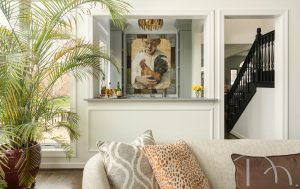
The bar cabinets were built to cocoon a treasured piece of art owned by my clients. Every color and surface was chosen as a coordinating enhancer for the art./Photo by Karen Palmer
___________________________



